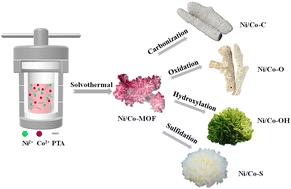当前位置:
X-MOL 学术
›
Inorg. Chem. Front.
›
论文详情
Our official English website, www.x-mol.net, welcomes your
feedback! (Note: you will need to create a separate account there.)
Exploring the optimal post-treatment strategy for boosting the electrochemical performances of a new bimetal–organic framework-based supercapacitor
Inorganic Chemistry Frontiers ( IF 6.1 ) Pub Date : 2024-10-24 , DOI: 10.1039/d4qi02314e Xinwen Dou, Mingyue Liu, Tian Cao, Chan Wang, Yingjie Zhang, Yuhang Jia, Qiang Ju, Zhenlan Fang
Inorganic Chemistry Frontiers ( IF 6.1 ) Pub Date : 2024-10-24 , DOI: 10.1039/d4qi02314e Xinwen Dou, Mingyue Liu, Tian Cao, Chan Wang, Yingjie Zhang, Yuhang Jia, Qiang Ju, Zhenlan Fang

|
Metal–organic frameworks (MOFs) have attracted great interest owing to their potential application in electrochemical energy storage. However, the poor conductivity, low structural stability and specific capacitance of pristine MOFs limit their practical applications in energy storage devices. To solve these issues, different post-treatment methods have been applied to MOFs to obtain their derivatives, which are expected to exhibit unique porous structures, fascinating morphologies, different chemical compositions, improved conductivity and stability as well as fascinating electrochemical behaviors. Nevertheless, to the best of our knowledge, systematic investigations on the effects of different post-treatment methods on the electrochemical behaviors of MOF derivatives have never been reported. Herein, we synthesized a series of new monometallic and bimetallic Ni/Co-MOFs with varied ratios of Ni to Co ions through the self-assembly of metal ions and terephthalic acid (BDC). Four different types of post-treatment methods, namely, sulfidation, carbonization, oxidation, and hydroxylation, were applied in the bimetallic Ni/Co-MOF with a 2 : 1 ratio of Ni to Co (Ni2Co1-MOF) due to its best electrochemical behavior among these MOF precursors, and the generated MOF derivatives were named as Ni2Co1–S, Ni2Co1–C, Ni2Co1–O and Ni2Co1–OH, respectively. The obtained optimized Ni2Co1–S-140-6 electrode showed the highest specific capacitance (1500 F g−1 at 1 A g−1), the best conductivity (Rs = 2.38 Ω), excellent rate capability (73.3%) and the highest cycle stability (88.2% retention after 5000 cycles) compared to those of Ni2Co1–C, Ni2Co1–O and Ni2Co1–OH electrodes, demonstrating that sulfidation was the best post-treatment strategy. Moreover, an aqueous asymmetric supercapacitor (A-ASC) assembled with the cathode of Ni2Co1–S-140-6 and the anode of PPy and in situ grown on acid-etched carbon cloth (AECC) exhibited a wide voltage window (1.7 V), competitive energy density of 147 W h kg−1 at a power density of 845 W kg−1 and ideal long-term stability with a specific capacitance retention of 75.9% after 5000 cycles at 10 A g−1. This work offers full view of the post-synthetic strategies for MOFs to develop high-performance electrochemical energy storage devices.
中文翻译:

探索提高新型基于双金属有机框架的超级电容器电化学性能的最佳后处理策略
金属有机框架 (MOF) 因其在电化学储能中的潜在应用而引起了极大的兴趣。然而,原始 MOF 的电导率差、结构稳定性低和比电容限制了它们在储能器件中的实际应用。为了解决这些问题,人们对 MOF 应用了不同的后处理方法来获得其衍生物,预计这些衍生物将表现出独特的多孔结构、迷人的形态、不同的化学成分、改进的导电性和稳定性以及迷人的电化学行为。然而,据我们所知,关于不同后处理方法对 MOF 衍生物电化学行为影响的系统研究从未报道过。在此,我们通过金属离子和对苯二酸 (BDC) 的自组装合成了一系列具有不同比例 Ni 和 Co 离子的新型单金属和双金属 Ni/Co-MOFs。由于在这些 MOF 前驱体中具有最好的电化学行为,因此在双金属 Ni/Co-MOF 中应用了四种不同类型的后处理方法,即硫化、碳化、氧化和羟基化,Ni 与 Co (Ni2Co1-MOF) 的比例为 2:1,生成的 MOF 衍生物命名为 Ni2Co1-S, 分别为 Ni2Co1-C、Ni2Co1-O 和 Ni2Co1-OH。 与 Ni 2 Co 1–C、Ni 2 相比,获得的优化 Ni2Co1–S-140-6 电极显示出最高的比电容(1 A g-1 时为 1500 F g-1)、最佳电导率 (Rs = 2.38 Ω)、优异的倍率能力 (73.3%) 和最高的循环稳定性(5000 次循环后保留 88.2%)与 Ni2Co1-C、Ni2 相比Co1–O 和 Ni2Co1–OH 电极,表明硫化是最好的后处理策略。此外,用 Ni2Co 1-S-140-6 的阴极和 PPy 的阳极组装的水性不对称超级电容器 (A-ASC) 在酸蚀碳布 (AECC) 上原位生长,在 845 W kg-1 的功率密度下表现出宽电压窗口 (1.7 V)、147 W h kg-1 的竞争能量密度以及理想的长期稳定性,在 10 A g−1 下循环 5000 次后,比电容保持率为 75.9%。这项工作全面展示了 MOF 开发高性能电化学储能器件的后合成策略。
更新日期:2024-10-24
中文翻译:

探索提高新型基于双金属有机框架的超级电容器电化学性能的最佳后处理策略
金属有机框架 (MOF) 因其在电化学储能中的潜在应用而引起了极大的兴趣。然而,原始 MOF 的电导率差、结构稳定性低和比电容限制了它们在储能器件中的实际应用。为了解决这些问题,人们对 MOF 应用了不同的后处理方法来获得其衍生物,预计这些衍生物将表现出独特的多孔结构、迷人的形态、不同的化学成分、改进的导电性和稳定性以及迷人的电化学行为。然而,据我们所知,关于不同后处理方法对 MOF 衍生物电化学行为影响的系统研究从未报道过。在此,我们通过金属离子和对苯二酸 (BDC) 的自组装合成了一系列具有不同比例 Ni 和 Co 离子的新型单金属和双金属 Ni/Co-MOFs。由于在这些 MOF 前驱体中具有最好的电化学行为,因此在双金属 Ni/Co-MOF 中应用了四种不同类型的后处理方法,即硫化、碳化、氧化和羟基化,Ni 与 Co (Ni2Co1-MOF) 的比例为 2:1,生成的 MOF 衍生物命名为 Ni2Co1-S, 分别为 Ni2Co1-C、Ni2Co1-O 和 Ni2Co1-OH。 与 Ni 2 Co 1–C、Ni 2 相比,获得的优化 Ni2Co1–S-140-6 电极显示出最高的比电容(1 A g-1 时为 1500 F g-1)、最佳电导率 (Rs = 2.38 Ω)、优异的倍率能力 (73.3%) 和最高的循环稳定性(5000 次循环后保留 88.2%)与 Ni2Co1-C、Ni2 相比Co1–O 和 Ni2Co1–OH 电极,表明硫化是最好的后处理策略。此外,用 Ni2Co 1-S-140-6 的阴极和 PPy 的阳极组装的水性不对称超级电容器 (A-ASC) 在酸蚀碳布 (AECC) 上原位生长,在 845 W kg-1 的功率密度下表现出宽电压窗口 (1.7 V)、147 W h kg-1 的竞争能量密度以及理想的长期稳定性,在 10 A g−1 下循环 5000 次后,比电容保持率为 75.9%。这项工作全面展示了 MOF 开发高性能电化学储能器件的后合成策略。


















































 京公网安备 11010802027423号
京公网安备 11010802027423号